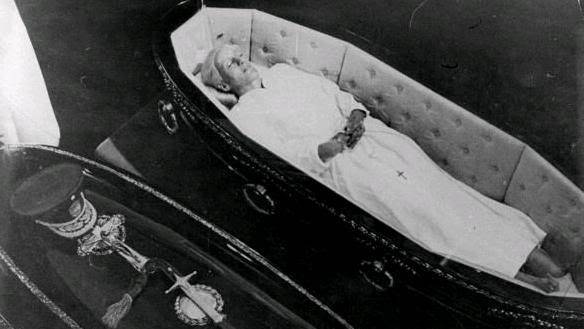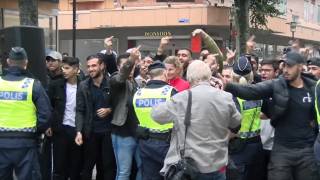The Travelling Corpse of Eva Perón

"In all of Latin America, only one other woman has aroused an emotion, devotion and faith comparable to those awakened by the Virgin of Guadalupe. In many homes, the image of Evita is on the wall next to the Virgin."
~The Oxford Illustrated History of Christianity, John McManners
The story of Eva Duarte, who rose from an illegitimate child of a poor provincial woman in Argentina to one of the most powerful woman of her time, was nothing short of a fairytale. She met Col. Juan Peron when she was just 24, and as his lover, she not only built his political charisma but also started a populist movement to reinstate him when he was ousted in 1945.
Their marriage came in 1947, a year before Peron became the president of Argentina. When Eva’s lowly birth caused many upper-class ladies to shun her from their charities and garden parties, she started her own Eva Peron Social Aid Fund. The people were mesmerized by her ‘generosity’ while the First Couple used the Fund for their own luxurious lifestyle. Then came tragic ending: Eva succumbed to cancer in 1952, just 33 year old. Her body was embalmed, a process made almost impossible since it was ravaged and emaciated by cancer. The embalmer was Dr. Pedro Ara who carried the perfectly preserved head of a peasant as a specimen of his work. Ara embalmed Evita only long enough for a public viewing, which stretched from a few days to a few weeks as the crowds kept pouring in. Two million people filed past her coffin, and seven were killed in the crush.
Then came tragic ending: Eva succumbed to cancer in 1952, just 33 year old. Her body was embalmed, a process made almost impossible since it was ravaged and emaciated by cancer. The embalmer was Dr. Pedro Ara who carried the perfectly preserved head of a peasant as a specimen of his work. Ara embalmed Evita only long enough for a public viewing, which stretched from a few days to a few weeks as the crowds kept pouring in. Two million people filed past her coffin, and seven were killed in the crush.
A second embalming, to prepare it for her mausoleum, planned to be larger than the Statue of Liberty, took two years and cost over $100,000 dollars. Before it was finished and the monument got past the digging stage, Peron was overthrown. The Perons’ homes were opened to the public–there were 15 custom-built sports cars, 250 motor scooters, Eva’s countless furs, jewels and $10 million in ‘ready cash’.
[...]
Back in 1955, the junta that overthrew Peron was stuck with Eva’s corpse, which they didn’t want to destroy nor bury (to prevent the grave from becoming a pilgrimage site). They cut off a finger from the corpse and analyzed it to make sure the object was really human. They moved it from site to site, and surrounded by a cast of curious characters that included a few necrophiliac guards, an army major who shot his wife while the corpse was in their apartment, a group of soldiers who accidentally bayoneted themselves while driving the corpse in a van, and insider informants to Peron camp who ensured that the corpse would be followed by flowers and candles that mysteriously appear overnight. Finally, the junta relented. In a futile attempt to prevent her from becoming a martyr, her body was smuggled out of the country and buried in Milan, Italy under the name of an Italian woman who died in Argentina. There in the land of Mussolini, anti-Fascist sentiments ensured that she remained buried. For the time being.
When Peron was reinvited to salvage Argentina which had since spiraled down into calamity, one of his conditions was the return of his wife’s body. At around the same time, a former president, Pedro Eugenio Aramburu, was kidnapped and executed by guerrillas, who refused to return his body until Evita’s corpse was returned to “the people”. Aramburu left a sealed letter detailing her secret grave, and Evita was returned. (Aramburu’s body was also returned to his family.)
Aside from a broken nose, damaged feet, and a few gashes on her face, Evita was actually in pretty good shape. She was kept at Perón’s villa, even sitting in the dinner room while Peron and his new wife Isabel ate their meals. Isabel combed the corpse’s hair in a daily devotion and, at Juan’s request, lie inside the coffin next to Evita to absorb some of her political magic. In 1974, Juan returned to power as president of Argentina. Upon his death, Isabel succeeded him and returned Eva’s body to Argentina where it was briefly displayed next to Juan’s body (below).

Isabel was overthrown in 1976. The new military leaders had Eva Peron’s body safely buried in the Duarte family tomb under three plates of steel in the Recoleta Cemetery in Buenos Aires. The tomb was said to be secure enough to withstand a nuclear attack or a restless corpse. Peron wasn’t so lucky–thieves stole into his coffin in 1987 and cut of his hands, demanding an $8m ransom. None was forthcoming, and so the hands were destroyed.
Read the full article at: iconicphotos.wordpress.com
"This collection of pictures ilustrates history presented by Tomas Eloy Martinez in his book "Santa Evita". Eva Peron embalmed body become sort of peronist relic, making her even more powerful after her death.
NOTE: Presentation is strictly made as a historical material."
Video from: YouTube.com






















